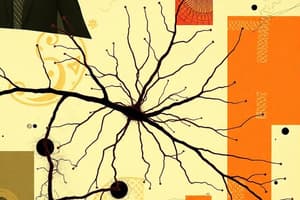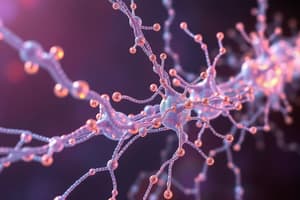Podcast
Questions and Answers
What is the primary building block of microtubules?
What is the primary building block of microtubules?
- Keratin
- Actin
- Tubulin (correct)
- Vimentin
How are tubulin dimers arranged within a microtubule's structure?
How are tubulin dimers arranged within a microtubule's structure?
- Randomly distributed
- In a single helix
- Arranged in a stacked, crystalline lattice
- Organized into 13 parallel protofilaments (correct)
What is the approximate diameter of a typical microtubule?
What is the approximate diameter of a typical microtubule?
- 25 nm (correct)
- 7 nm
- 10 nm
- 8-12 nm
Which of the following processes is directly influenced by GTP hydrolysis in microtubules?
Which of the following processes is directly influenced by GTP hydrolysis in microtubules?
What is the role of nucleation in microtubule formation?
What is the role of nucleation in microtubule formation?
Which cellular component serves as the primary microtubule organizing center (MTOC)?
Which cellular component serves as the primary microtubule organizing center (MTOC)?
What is a key function of microtubules within the cytoplasm?
What is a key function of microtubules within the cytoplasm?
In which direction do kinesins typically move along microtubules?
In which direction do kinesins typically move along microtubules?
Which of the following is a common application of microtubule-targeting drugs?
Which of the following is a common application of microtubule-targeting drugs?
How do tubulin-binding drugs affect cancerous cells?
How do tubulin-binding drugs affect cancerous cells?
How does Paclitaxel (Taxol) affect microtubules to treat cancer?
How does Paclitaxel (Taxol) affect microtubules to treat cancer?
What effect does Colchicine have on microtubules?
What effect does Colchicine have on microtubules?
What type of cellular function is commonly affected by drugs that destabilize microtubules?
What type of cellular function is commonly affected by drugs that destabilize microtubules?
Relative to actin filaments and microtubules, how would you describe the stability of intermediate filaments?
Relative to actin filaments and microtubules, how would you describe the stability of intermediate filaments?
Where are intermediate filaments typically anchored within a cell?
Where are intermediate filaments typically anchored within a cell?
What type of stress are intermediate filaments best suited to resist?
What type of stress are intermediate filaments best suited to resist?
How many protofilaments form an intermediate filament?
How many protofilaments form an intermediate filament?
Which category includes intermediate filaments found specifically in nerve cells?
Which category includes intermediate filaments found specifically in nerve cells?
Which class of intermediate filaments is involved in the dissolution of the nuclear membrane during mitosis?
Which class of intermediate filaments is involved in the dissolution of the nuclear membrane during mitosis?
What is the diameter of an intermediate filament?
What is the diameter of an intermediate filament?
Which of the following is NOT a main function of intermediate filaments?
Which of the following is NOT a main function of intermediate filaments?
Which component regulates cell-cycle progression?
Which component regulates cell-cycle progression?
Regarding dynamic instability, the hydrolysis of GTP plays and important role in:
Regarding dynamic instability, the hydrolysis of GTP plays and important role in:
What is the role of plectin?
What is the role of plectin?
What is the purpose of motor linkage factors?
What is the purpose of motor linkage factors?
Flashcards
Microtubules
Microtubules
The major components of the cytoskeleton, polymers of tubulin protein, and part of the tubulin protein superfamily. They play roles in structural support, transport, and DNA segregation.
Microtubule Structure
Microtubule Structure
Microtubules are hollow tubes with a diameter of ~25 nm, are composed of tubulin dimers (alpha and beta subunits), and are organized in 13 parallel protofilaments.
Microtubule Dynamic Instability
Microtubule Dynamic Instability
Microtubules display dynamic behavior, binding GTP for polymerization, allowing rapid cell reorganization, with GTP hydrolysis playing an important role.
Microtubule Formation
Microtubule Formation
Signup and view all the flashcards
Microtubule Function
Microtubule Function
Signup and view all the flashcards
Microtubules & Motor Proteins
Microtubules & Motor Proteins
Signup and view all the flashcards
Kinesin Function
Kinesin Function
Signup and view all the flashcards
Microtubule-Targeting Drugs
Microtubule-Targeting Drugs
Signup and view all the flashcards
Tubulin-Binding Drugs
Tubulin-Binding Drugs
Signup and view all the flashcards
Microtubule-Stabilizing Agents
Microtubule-Stabilizing Agents
Signup and view all the flashcards
Microtubule-Destabilizing Agents
Microtubule-Destabilizing Agents
Signup and view all the flashcards
Intermediate Filaments
Intermediate Filaments
Signup and view all the flashcards
Intermediate Filament Assembly
Intermediate Filament Assembly
Signup and view all the flashcards
Properties of Intermediate Filaments
Properties of Intermediate Filaments
Signup and view all the flashcards
Type I: Keratins
Type I: Keratins
Signup and view all the flashcards
Type II: Vimentin
Type II: Vimentin
Signup and view all the flashcards
Type III: Neurofilaments
Type III: Neurofilaments
Signup and view all the flashcards
Type IV: Nuclear Lamins
Type IV: Nuclear Lamins
Signup and view all the flashcards
Intermediate Filament Dysfunction: ALS
Intermediate Filament Dysfunction: ALS
Signup and view all the flashcards
Study Notes
- Cytoskeleton includes Microtubules, also known as intermediate filaments
Microtubules
- Microtubules are polymers of the protein tubulin and are components of the cytoskeleton
- Microtubules are major components of the cytoskeleton
- Tubulin protein is a superfamily of globular proteins
- Alpha- and beta-tubulins polymerize into microtubules
- Microtubules function as structural support, aid intracellular transport, and assist in DNA segregation
Microtubules - Structure
- Microtubules are hollow tubes, approximately 25 nm in diameter
- Microtubules comprised of tubulin dimers, with alpha and beta subunits
- Organized into 13 parallel protofilaments
Microtubules – Dynamic Instability
- Microtubules exhibits dynamic behavior, binding GTP for polymerization
- Dynamic assembly and turnover allow the cell to rapidly reorganize its cytoskeleton
- GTP hydrolysis plays an important role in this process
- Alpha- and beta-tubulin dimers bind to GTP to form microtubules
- GTP-dimers assemble onto the (+) ends of microtubules
- Beta-tubulin is exposed on the (+) end, while alpha-tubulin is exposed on the (-) end
- After incorporation into the microtubule, GTP on beta-tubulin hydrolyzes into GDP
- The stability of the dimer influenced by whether beta-tubulin is bound to GTP or GDP
- Dimers bound to GTP tend to assemble into microtubules, leading to growth
- Dimers bound to GDP tend to disassemble, leading to shrinkage
Microtubules - Formation
- Microtubule growth requires nucleation
- Nucleation initiates de novo formation of microtubules
- Microtubules form at distinct structures called Centrosomes
- A centrosome is an organelle that serves as the main microtubule organizing center (MTOC)
- Microtubules emerge from the centrosome structure
- Centrosomes regulate cell-cycle progression
- MTOCs function in the organization of eukaryotic flagella and cilia
- MTOCs function in the organization of mitotic and meiotic spindle apparatus
- Mitotic and meiotic spindle separates the chromosomes during cell division
Microtubules - Function
- Microtubules actively transport organelles within the cytoplasm.
- Functions include Endocytosis, Exocytosis, Mitochondria movement, and Protein transport between the ER and Golgi
Microtubules and Motor Proteins
- Motor proteins generate force and 'walk' along microtubules
- Kinesins move toward the (+) end
- Dyneins move toward the (-) end
- The 'head' domain of these proteins binds to the microtubule, whilst the tail domain binds to membrane or cargo
Kinesin
- Motor proteins function in concert with microtubules
- Motor provide transport for organelles and vesicles
Microtubule Drugs
- Tubulin-binding drugs kill cancerous cells by inhibiting microtubule dynamics, which are required for DNA segregation and cell division
- Agents which stabilize microtubules (e.g., Paclitaxel (Taxol®)) used in Ovarian and breast cancers
- These agents prevent dissociation of tubulin subunits as well as block mitosis, stabilizing GDP-bound tubulin
Microtubule-Disrupting Drugs
- Agents destabilizing microtubules include Colchicine
- Colchicine treats inflammatory conditions (Arthritis, gout)
- Colchicine promotes disassembly of microtubules, leading to dramatic change in organelle location
- Colchicine blocks migration of white blood cells, reducing inflammation.
Intermediate Filaments
- Intermediate filaments are of various proteins, depending on the type of cell that they are in.
- Averaging 10 nm in diameter
- More stable than actin filaments
- Heterogeneous component of the cytoskeleton
- Frequently bound to plasma membrane at cell-cell junctions and also found within the nucleus.
- Impart resistance to stress
Intermediate Filament Assembly
- Two polypeptides wind around each other in a coiled-coil structure to form dimers
- Dimers associate in a staggered antiparallel fashion to form tetramers
- Tetramers associate end to end to form protofilaments and laterally to form filaments
- Each filament contains approximately eight protofilaments wound around each other in a ropelike structure
Intermediate Filaments Function
- Toughest of cytoskeletal components
- Further stabilized though interaction with accessory proteins
- Plectin links the cytoskeleton to the plasma membrane and connects cells
- Impart resistance to stress
- Function in the maintenance of cell-shape by bearing tension (during mitosis and during the positioning of the centrosome)
- Resist compression
Classes of Intermediate Filaments
- Whereas actin filaments and microtubules are polymers of single types of proteins, intermediate filaments are composed of a variety of proteins that are expressed in different types of cells
- There are 4 classes of intermediate filaments
- Type I : keratins are found in hair and nails
- Type II: vimentin within cellular membranes and connective tissue and muscle.
- Type III: neurofilaments
- Type IV: nuclear lamins within the lumen of the nucleus, and is involved in dissolution of nuclear membrane in mitosis
Intermediate Filament Dysfunction
- Abnormalities of neurofilaments leads to diseases in motor neurons, specifically amyotrophic lateral sclerosis (ALS).
- ALS (Lou Gehrig's disease; motor neurone disease) leads to progressive loss of motor neurons
- This leads to muscle atrophy, paralysis, and eventual death
- ALS and other types of motor neuron disease are characterized by the accumulation and abnormal assembly of neurofilaments
- The resulting intermediate filament supports the axons of nerve cells.
Studying That Suits You
Use AI to generate personalized quizzes and flashcards to suit your learning preferences.



